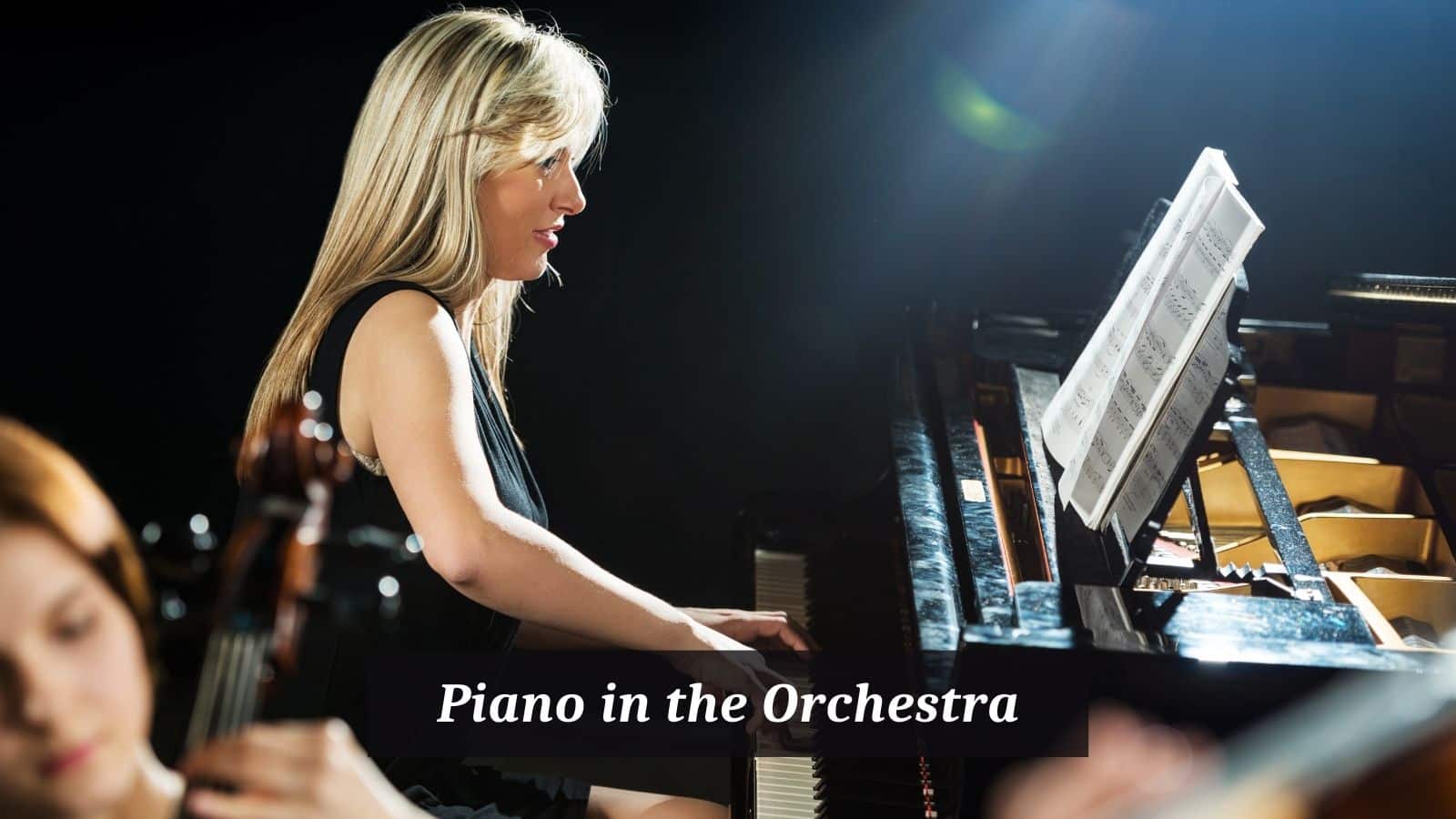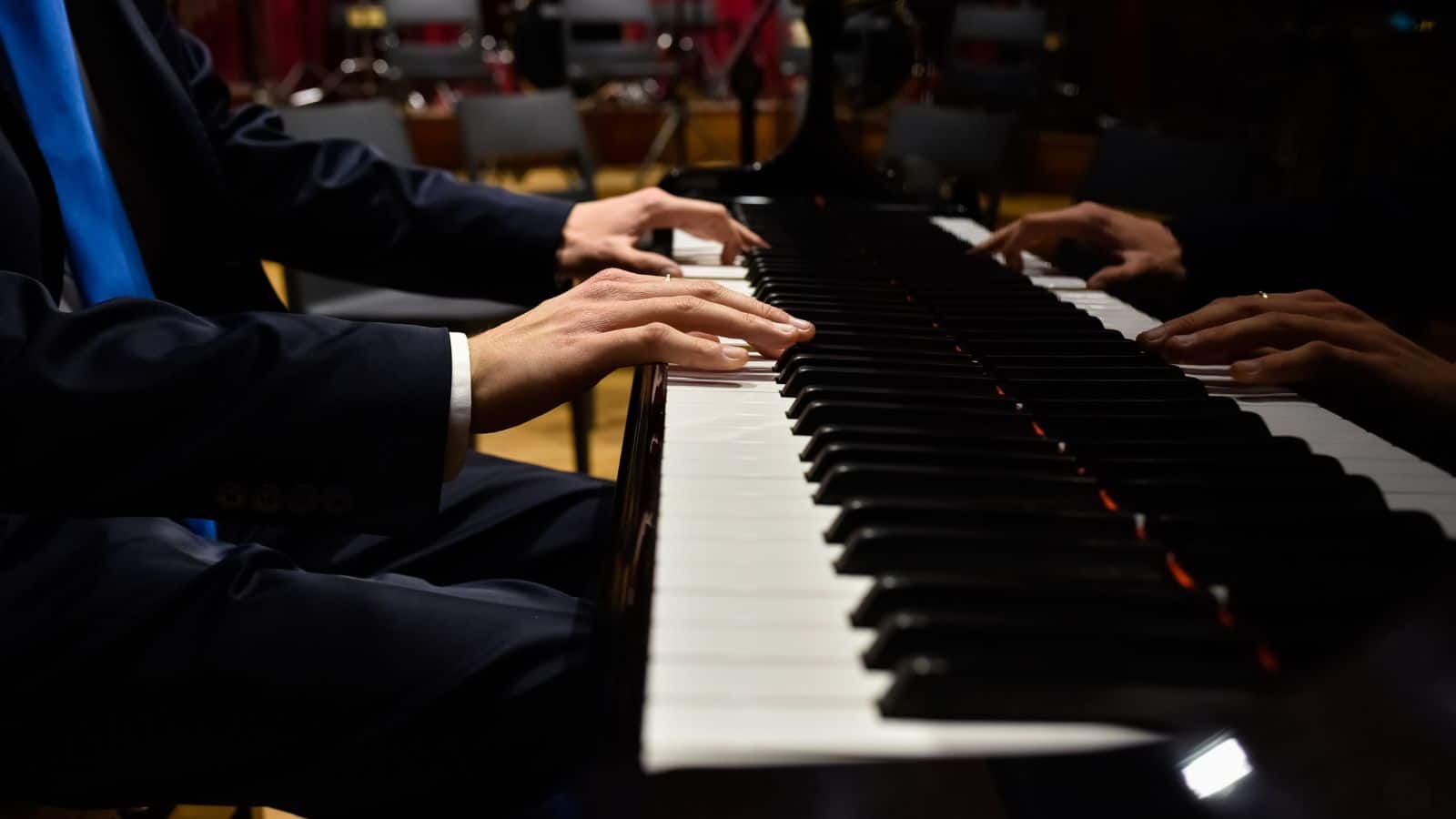
You may have a clear image of the noble piano as a solo, somewhat lonely instrument. It’s a self-sufficient 88-toothed beast that does do quite nicely alone but it is also an instrument that makes a huge contribution to other ensembles, from Piano Trios to playing its part in the orchestral setting.
I’m not referring to when the piano takes center stage as a soloist. There are numerous concertos composed for the instrument that is with an orchestra, but this is not where we’re travelling.
Rather than as a lead protagonist, I’m exploring the piano within the orchestra, used as an integral component to that largest of ensembles.
Piano in the Orchestra
I feel it is worth mentioning briefly that keyboards have been a key component of larger ensembles for hundreds of years. Consider the harpsichord from which the orchestras of the Baroque were frequently led.
The function of this keyboard was also to accompany and provide solo passages. Later, Mozart directed from the piano too, but here I am thinking of his concertos.
One possible exception could be Mozart’s Concertante (K.505), which he composed for a soprano whom he was enamored with. One story suggests that the piano part was to bring him closer to the object of his desire.
It wasn’t until the 20th century that the piano was properly incorporated into the orchestral pallet. There are a few exceptions that I’m aware of, and these include Gustav Mahler’s Symphony No.8, and Camille Saint-Saëns Symphony No.3.
The piano doesn’t play a huge part in either of these works, but it is there, often supplying more of a textural effect than a melodic line.
Another contender for the earliest inclusion of the piano might be Berlioz Lélio (Op 14b) from around 1832. Again, the piano is used for effects here, all be it very convincingly.
In many respects, the piano presents a few challenges for the composer. How and why is it to be employed if not as a solo instrument? Most commonly, it is a grand piano that is part of the orchestra, not an upright, so the sound can be overpowering across the seven-and-a-quarter octave range.
The piano is a highly percussive instrument. After all, the sound is created by hammers hitting strings. This presents the other dilemma. Is the piano a percussion instrument or something else?
If you were to ask Bela Bartok, the answer may be percussion, but the fact is it can also be vibrantly textural, not purely rhythmic. The piano has much to offer the orchestra.
The orchestral piano can bring a multitude of creative possibilities to the composer’s table. Today, the piano is a regular member of the orchestra, just as the vibraphone, harp, celeste, marimba, and other once highly exotic instruments.
Shostakovich makes extensive use of the piano as an orchestral instrument in his symphonies. (He also composed two fine piano concertos for the instrument and his famous Preludes and Fugues).
In his Fifth Symphony, the piano first enters at figure 17, movement one, as the tempo picks up towards 92 BPM. Shostakovich marks the piano to be played with the una corda pedal dryly.
What the piano is doing is doubling the basses and cellos. It follows the gradually ascending line right through into the violin pizzicato line.
For the most part, the piano is used to reinforce lines of music and add sonority and rhythm. In his seventh symphony, Shostakovich employs the piano in much the same way, bringing a percussive color to the score.
American composer Aaron Copland incorporates the piano into many of his orchestral scores. One of my favorites is the ballet score Rodeo.
In the hoe down around figure 76 in the original score, the piano takes up the accompanimental chord pattern playing in the upper strings and double bass. It returns later in the third dance supporting the syncopated figure in the trumpets and woodwind.
In a similar way to Shostakovich, Copland fully exploits the percussive qualities of the instrument alongside the unique timbre it offers. Copland exposes the piano more than Shostakovich, allowing it more prominence in the score.
In Alban Berg’s terrifying opera Wozzeck (1914-1922), we find ourselves in a dark place. Even at the start of the opera, to me, there is an uncomfortable feeling, and before long, Wozzeck descends into madness.
Aside from the extraordinary music, Berg’s orchestration is equally remarkable. Berg uses a fairly large orchestra in the pit but calls for three additional ensembles to take their place on the stage.
In the Tavern Band, Berg scores a clarinet, accordion, bombardon, or tuba, guitar and two violins. He also asks for an out-of-tune upright piano. Whilst not entirely part of the orchestra, this is an incredible and haunting use of the piano.
American composer Charles Ives was not a composer shy of taking a few risks with his music. His catalogue of works offers every listener a richly varied view of what music can be.
Ives was a highly experimental composer. It seems that with each new piece he composed, his ideas explored yet another facet of music and its possibilities. In his Fourth Symphony (1910-24), Ives does not fail to surprise.
His instrumentation for this work is generous and diverse and includes an orchestral piano requiring two players. (Ives even asks for a Theremin should one be available).
In addition, Ives adds a solo piano plus a quarter-tone piano that is not often readily available. This example is perhaps the most comprehensive and fascinating use of the piano (or pianos), in an orchestral setting.
There is a long list of pieces that include the piano in the orchestra. Others not listed here that you might wish to explore include Stravinsky’s Petrushka and Symphony in Three Movements, Benjamin Britten’s opera Turn of the Screw and War Requiem, plus Prokofiev’s Fifth Symphony.
As the piano has become a familiar face in the orchestra, composers have been able to extend the sound of this greatest of ensembles in some adventurously wonderful ways.

